The EU Pet Travel Scheme: How to Complete Pet Passports
17 min read
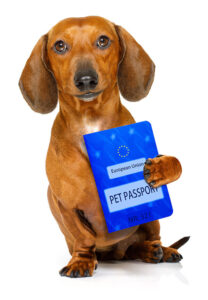
The Pet Travel Scheme (PETS) allows pet dogs, cats and ferrets to enter the UK without quarantine, as long as they meet the conditions of the scheme. UK pet owners can also take their dogs, cats and ferrets abroad and bring them back into the UK without the need for quarantine, provided their pets meet the conditions of the scheme.
The general requirements for exports from the UK to EU countries are:
• Microchip (or legible tattoo imprinted prior to 3 July 2011)
• Rabies vaccination (pet must be at least 12 weeks of age)
• 21 day wait before being eligible to travel to other EU countries
• Pet passport.
See https://www.gov.uk/take-pet-abroad for further details.
ISSUING A PET PASSPORT #
A passport can be issued for an animal that has been microchipped and vaccinated against rabies. If an animal is going to re-enter the UK from an unlisted Third Country, it must also pass a serology test for rabies.
A passport can also be issued for an animal accompanied by a Third Country certificate which has been issued in a nonEU country. The animal must be microchipped and have a current rabies vaccination (and have been blood tested, in the case of an unlisted Third Country). The Third Country certificate is valid for up to four months’ further movement within the EU after entry.
WHO CAN ISSUE A PET PASSPORT #
Where required, the passport should be stamped and signed by an Official Veterinarian (OV) (OCQ(V)CA or SX). Other sections of the passport may be completed, signed and stamped on the basis of evidence of procedures carried out by any registered veterinary surgeon. This evidence may be in the form of:
• a completed EU pet passport issued by another authorised veterinarian
• a record or certificate of current rabies vaccination which bears the microchip/tattoo number of the animal, from any registered veterinarian
• a blood test result provided by a recognised laboratory showing a test result indicating a rabies antibody titre of equal to or greater than 0.5 IU/ml. This document must also bear the animal’s microchip/tattoo number and date of rabies vaccination carried out prior to blood sampling.
OVs in the UK can also enter details, such as rabies vaccination boosters or of tapeworm treatment (if appropriate), in a passport issued in another EU country.
The pet passport can be completed in any colour ink.
I: OWNER DETAILS #
The first name(s), surname and full address of the person to whom the passport is first issued should be entered in Part 1 of this page. The owner must sign in this section of the passport.
• The owner named in the passport must be aged over 16.
Change of owner/address #
If the owner of the animal reports a change of address to a veterinary
practice, the details of the new address along with the owner’s name
should be entered in the next available section and again have an owner
signature.
If there is a subsequent change of ownership, the client can enter the
details in the next section and sign.
Joint ownership
The EU Regulation is purposefully designed with one owner in mind and
never makes reference to more than one owner. Cependant, pet owners may
authorise another person in writing to accompany the pet if they aren’t able
to travel.
Authorised person
The pet owner named in Section I may give written authorisation to another
person to travel with their pet. This authorisation does not need to follow
any particular format, but should contain the details of the owner, the
details of the authorised person, and the pet details i.e. microchip number
etc..
Non-permanent or correspondence addresses
There is no requirement for an owner to have a permanent residential
address in order to be issued with a pet passport. The passport can be
issued with a correspondence address recorded in Section I.
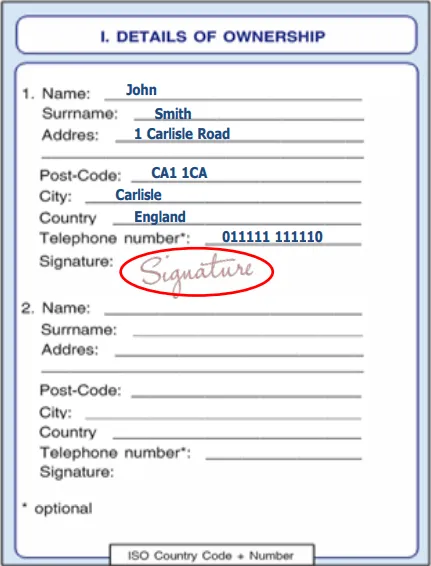
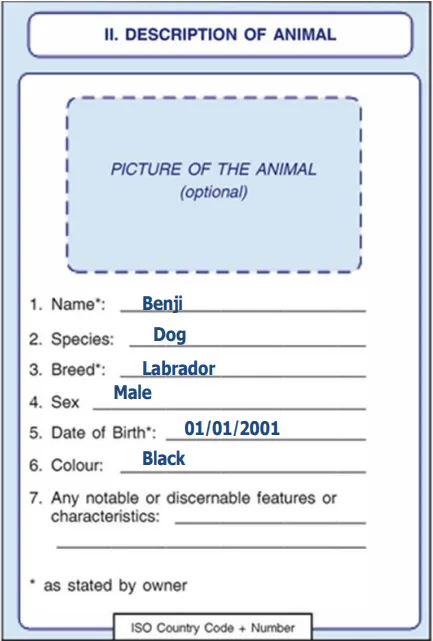
II: DESCRIPTION OF ANIMAL #
Insertion of a photograph of the animal is optional, and at the owner’s expense. The owner is responsible for affixing the photograph to the passport. The borders of the photograph must remain within the marked area and not obscure any other part of this page.
• Parts 1-7 can be completed by practice support staff or a veterinarian.
• The entry for species must be either dog, cat or ferret.
• The date of birth entry may contain the animal’s full date of birth, month and year of birth, or just year of birth, as stated by the owner. If the date of birth is not known, an approximate date may be entered.
III: MARKING OF ANIMAL #
Can be completed by practice support staff or a veterinarian.
The microchip/transponder must be scanned and read before any entry is made in this section.
Date of application or reading of the transponder #
The date of application or reading must not postdate any compulsory vaccination or
treatment. The entry should be in the format dd/mm/yyyy. This section must not be left
blank. Do not enter ‘not known’.
• If a microchip has been implanted and can be read, but the exact date of microchipping
is not known, enter the date of the reading. The appropriate deletion should be made to
show which date is being declared.
• Where certifying this information on the basis of evidence provided by another veterinary
surgeon, ensure that this date does not postdate any compulsory vaccination or
treatment.
Location of transponder #
Insert location of microchip as indicated by passing the reader over the animal.
Tattooing #
Tattoos are not acceptable as a means of identification, unless administered before 3 July 2011. If an inspection of the animal reveals a clearly legible tattoo number, this can be
entered in this section.
Lamination #
Once this section is completed, the page must be laminated using the laminate sheet provided. If a mistake is identified after the lamination is sealed, a new passport will need to be issued.
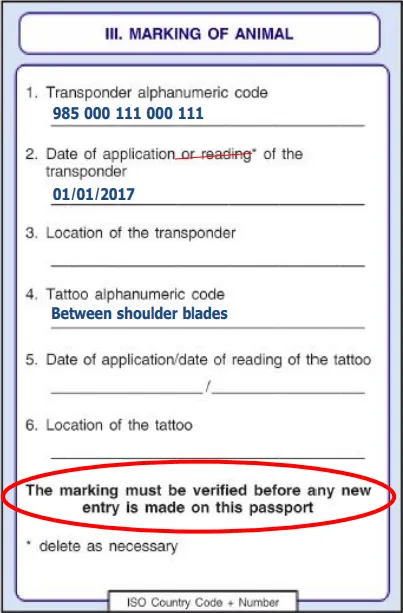

IV: ISSUING OF THE PASSPORT #
- The passport is issued when Sections I, II, III and IV are completed.
- This page must be completed by an OV and the OV stamp used.
- The address and telephone number should be that of the practice where the passport is issued.
- OVs should enter their practice email address in this section where possible, although locum OVs may enter a private email address.
V: VACCINATION AGAINST RABIES #
- This page must be completed by an OV.
- Before any entry is made in any part of this section, the animal’s microchip number must be read and verified against the entry in section III of the passport. Details of the current rabies vaccination must be recorded in the passport.
- An approved inactivated rabies vaccine or recombinant vaccine must be used and administered in accordance with the recommendations of the manufacturer.
Manufacturer, Name of Vaccine and Batch number #
Where possible, the sticker supplied with each dose of vaccine should be inserted in this box. If the sticker does not provide all the required information, please enter any missing information immediately below or adjacent to the sticker. Where a sticker is not available, the required information may be entered by hand. There are additional lamination sheets included in the passport which are ‘kiss-cut’, and individual sections must be removed and placed over the vaccination sticker for each entry.
Vaccination Date/Valid From/Valid Until #
If an animal is already vaccinated, the date of vaccination can be entered on the basis of practice records or suitable supporting evidence, which must show the animal’s microchip number. A ‘valid from’ date should be entered for the first recorded vaccine. This date is the 21st day after the first vaccination, where the day of vaccination is day 0. Booster vaccinations given within the validity period of the previous vaccine do not need an entry in the ‘valid from’ field.
The ‘valid until’ date is the date when the next booster is due, and should where possible be based on the information in the manufacturer’s datasheet. If this is not available, valid until dates can be entered on the basis of practice records or suitable supporting evidence, which must show the animal’s microchip number. The valid until date will be one to three calendar years
after the vaccination date, depending on the validity period of the vaccine used e.g. vaccination date 01/01/2016, valid until 01/01/2019.
Authorised Veterinarian #
In new style pet passports, the OV stamp must not be used in this section. The OV should sign in this section and must enter their name, address, telephone number and SP number. A stamp with these details can be used.
Old style pet passports #
Old style pet passports (issued prior to December 2014) are valid for travel until all of the treatment spaces are filled. Rabies vaccinations can be added to old style pet passports, even if there has been a break in vaccine cover.
As old style pet passports do not have a box for the ‘valid from’ date, this information does not need to be included. The vaccine sticker does not need to be laminated.
A signature and SP stamp must be added to the ‘authorised veterinarian’ box in old style pet passports.
Booster vaccinations #
After a pet has been vaccinated, it will need regular booster vaccinations in accordance with the manufacturer’s datasheet. These must be given by the ‘Valid until’ date. If this date is missed the animal will not meet the conditions of the scheme and will have to be re-vaccinated. The animal will be eligible to travel 21 days after the vaccination.
If a booster has been missed since a blood test was carried out, the blood test will no longer be valid and the pet must be revaccinated and a further blood test performed at least 30 days after vaccination (if returning from an unlisted country).
Administering rabies vaccines with other medications #
In order to be able to certify a vaccination for pet travel, it must comply with the datasheet. If the datasheet indicates that the vaccine would not be effective when mixed with other drugs/vaccines or might otherwise not be protective (par exemple. in immunocompromised animals), OVs must seek advice from the vaccine manufacturer. OVs should only certify a rabies vaccination if the manufacturer can confirm that the animal will be protected in the proposed circumstances.
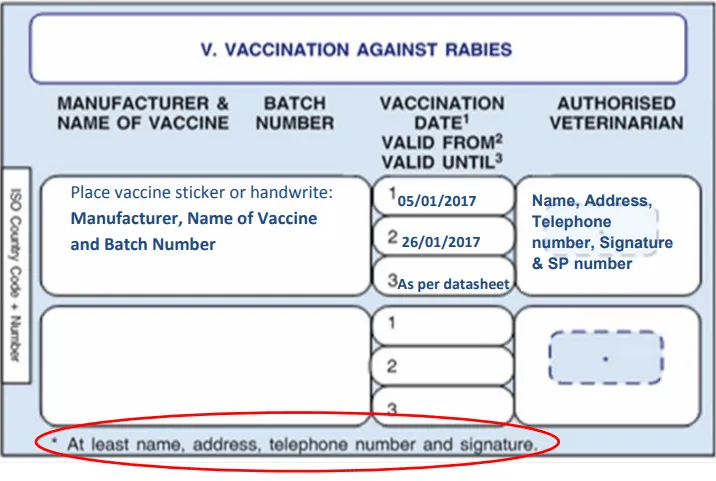
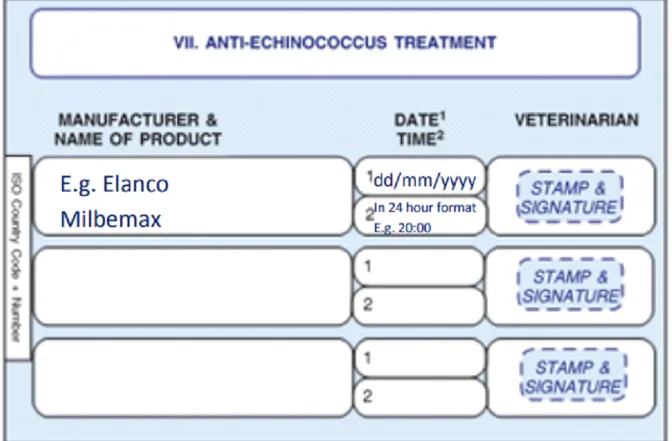
VII: ANTI-ECHINOCOCCUS TREATMENT #
- Before any entry is made in this section, the animal’s microchip number must be read and verified against the entry in section III of the passport.
- • Before entering or re-entering the UK, a dog must be treated by a qualified veterinarian against the tapeworm Echinococcus multilocularis. The treatment must be carried out not less than 24 hours and not more than 120 hours before the pet is landed in the UK (unless travelling directly from Finland, Ireland, Malta or Norway).
- • Dogs leaving the UK on short trips will need to have this treatment administered prior to departure from the UK. This is so the timing requirement described above can be satisfied.
Treatment #
The tapeworm treatment must contain praziquantel, or be a treatment proven to be effective against Echinoccocus multilocularis. It must be administered in accordance with the manufacturer’s instructions.
Completion #
The product details should be entered in the box marked ‘Manufacturer and name of product’. The date and time of treatment should be entered in the boxes marked ‘Date/Time’. Please enter the date in dd/mm/yyyy format. For the time, enter using 24-hour clock, par exemple. 15:30.
If the veterinarian administering treatment is an OV, their stamp must be entered in the box marked ‘veterinarian’. If the veterinarian administering treatment is not an OV, the practice stamp must be entered in the box. In both cases, the administering veterinarian must also sign in the box.
SECTIONS VIII, IX, X, XI AND XI #
Section VIII: Other Anti-Parasite Treatments #
Tick treatment in any pet – and tapeworm treatment in cats – is no longer mandatory. It is however recommended that additional attention is paid to these conditions for animals which travel under the Pet Travel Scheme. The use of this section is optional.
Section IX: Other Vaccinations #
It is not mandatory to complete this section. It may need to be completed if it is decided in the future that the passport can be accepted as an export document to enter a non-EU country. Cependant, veterinarians may enter details of vaccinations administered to the animal, other than against rabies, in this section.
Section X: Clinical Examination #
Whilst the entry for clinical examination is not required for the movement of dogs and cats to other EU countries, some transport companies may still require owners to produce evidence of an animal’s fitness to travel. OVs may, therefore, complete section X of the passport if they wish to do so. The OV should sign in this section and must enter name, address, telephone number and SP number. A stamp with these details can be used. The SP stamp must not be used in the signature field.
Section XI: Legalisation #
This section is not required to be completed at this time. It may need to be completed if it is decided in the future that the passport can be accepted as an export document to enter a non-EU country.
Section XII: Others #
This section should normally be left blank unless there are special circumstances or conditions that need to be recorded in relation to the passport. See section VI above in relation to missed rabies boosters.
OTHER IMPORTANT INFORMAT ION #
Record keeping #
Once a passport has been issued, we recommend that you take a photocopy/scan of the passport pages covering passport number, identification, vaccination and serology and retain them for reference. It is mandatory to retain these records for at least three years. The required records to be kept are:
- the passport number
- the location and number of transponder or tattoo, and the date of application or reading of that number
- pet’s name, species, breed, sex, colour, date of birth as stated by owner, and any other notable characteristics
- name and contact information of the owner.
Full Passports #
If the clinical examination section is full, OVs can use the following statement if issuing a letter to a client regarding an animal’s fitness to travel: “On (date), I examined the animal described in UK pet passport serial no (number) and found it to be free from clinical signs of infectious or contagious disease, including external parasites, and in my opinion, is fit for travel”.
If an essential section has become filled, (rabies vaccinations or tapeworm treatment), a new passport must be issued. If the need for a replacement is specifically due to the tapeworm treatment section being full (par exemple. a frequent traveller), a second passport may be issued for the dog, in which only sections I-IV are completed. There is no requirement to add previous rabies vaccination details to the second passport but both passports must always be presented for checks to verify the validity of the rabies vaccine entries in the new passport.
Where a second passport is issued, it is recommended that the date of reading of the microchip/tattoo should be the date as noted in the first passport. Where there is any issue or doubt with this date, it is permissible for the OV to use the current date that they themselves check the microchip/tattoo and issue the second passport. In this scenario so long as both passports are carried for travel, the animal will be seen to be compliant.
Lost or stolen passports #
If a passport is lost or stolen, it can be replaced on evidence of the animal’s vaccination record and blood test result (if applicable); both of which must show the animal’s microchip number. Details of the lost or stolen passport, including its serial number, country and date of issue (if known) and should be recorded on the Pet Passport Control Sheet.
Young animals #
The EU Regulation requires pets to be at least 12 weeks old when vaccinated. This means that no pet can enter the UK unless they are 15 weeks old (12 weeks + 21 day wait). The UK does not permit the entry of young unvaccinated pets.
Some EU Member States may accept dogs and cats under 12 weeks of age which have not been vaccinated against rabies, but are accompanied by a pet passport. In such cases it is possible to issue a passport without vaccinating the animal. There must be written evidence to support this.
Vet certifying own pet #
The RCVS Principles of Certification state that “Veterinarians should not issue a certificate which might raise questions of a possible conflict of interest e.g. in relation to their own animals”. On the basis of this, it is advised that treatment/certification to meet PETS requirements should be carried out by a qualified veterinarian who is not the owner of the pet.
Failed microchips #
In the event that the original microchip is unable to be scanned and read, the pet must be re-chipped. If the pet has been previously prepared for travel, then it must be re-prepared in accordance with pet travel rules and a new pet passport issued. A note should be added in Section XII of the passport, advising that there is another microchip present that cannot be scanned and read. This is in case the fault is intermittent and the failing chip is picked up at the port on entry to the UK.
Two microchips present #
In the event that an animal has two microchips, a passport should be issued with both microchip numbers recorded in Section III. Both entries must be covered by the lamination.
OVs should add a statement to Section XII of the passport that advises of the existence of another microchip. This statement may only be provided having read both microchips, and should state the following (or similar): “On (date) I scanned and read microchip number (number associated with PETS preparations). On the same occasion, I also successfully scanned and read microchip number (second microchip number).” This statement should be signed and stamped by the OV.
Intermittent microchips #
Should a pet have an intermittent (i.e. occasionally readable) microchip, the vet must firstly obtain a reading of the intermittent microchip. Having gained a reading, the vet may then insert a new microchip. This chip should be scanned both before and after insertion to ensure functionality. A new passport should be issued with both microchip numbers recorded in Section III and both entries must be covered by the lamination. The vet must then add a comment in the ‘Others’ section of the passport, stating: “On (date) I scanned and read microchip number (intermittent chip number). Having
gained a reading, I then inserted chip number (new chip number) on the same day, and in accordance with Defra requirements.”
This statement should be signed and stamped by the vet. When travelling, pet owners should advise portal staff to check the ‘Others’ section, in order that they can be assured a new microchip has been inserted to requirements.
Requesting further supplies of pet passports #
When further supplies of pet passports are required, the completed Control Sheet should be emailed to [email protected]. The control sheet must provide evidence that at least 15 of the previously received passports have been used. A further batch will not be forwarded without first receiving this evidence.
Amendments/Corrections #
Spoiled passports should be cancelled by cutting off the top right hand corner of the passport. Cancelled passports should be returned to the owner, or destroyed. When a passport becomes full, it should be cancelled as above and returned to the owner.
Any amendments to the passport must be made by the OV by drawing a single line over the incorrect entry. The correct information must be written legibly above the deleted entry and then initialled and stamped by the OV with the official stamp. The use of correction fluid is not permitted.
If an error is made in the date of rabies vaccination or the expiry date of that vaccine (Section V of the passport), the whole entry for that vaccination should be deleted and initialled and stamped.
A new entry for that vaccination should be entered in the next line in that section of the passport.

Source: Animal & Plant Health Agency
Powered by BetterDocs




